The Southeast region of the United States has a hot, humid climate with blistering summers and mild winters. Large shade trees provide some relief with a cooling effect during the long, hot months. Their beauty and value to wildlife make them an important part of the garden. Shade trees that are native to the region perform best in the climate and soils of the Southeast. Here are eight essential native shade trees that are reliable and easy to grow for gardeners in the Southeast.
Not in the Southeast? Browse plants native to other regions in the U.S.
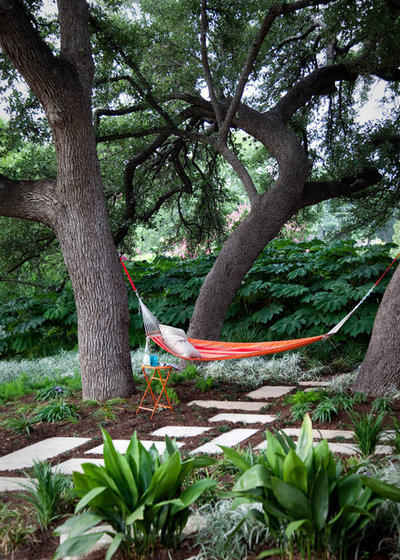
B. Jane Gardens
Southern Live Oak (
Quercus virginiana)
Native to coastal areas of the U.S. Southeast, from Virginia south to Florida and the keys, along the Gulf Coast and into coastal Texas
Southern live oak is a truly majestic evergreen tree that lines streets and graces parks in cities across the South. Yes, it can take a hundred years for them to reach their mature height of 40 to 80 feet tall and 60 to 100 feet wide. Plant one now so that your grandchildren will enjoy swinging from their spreading branches. Pictured here is a cluster of three southern live oaks, each with a unique twisted form, that create a relaxing cove for a hammock.
Water requirement: Water regularly to establish; mature trees have a low water requirement
Light requirement: Full sun
See how to grow southern live oak
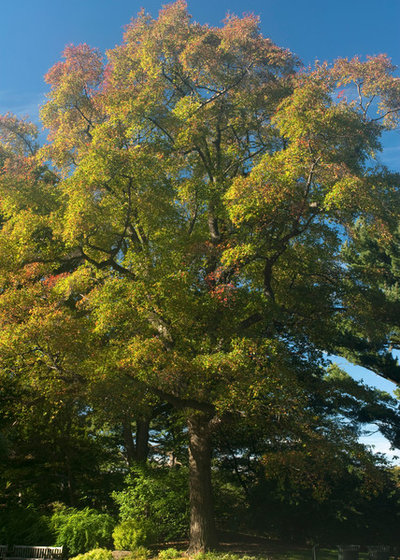
The New York Botanical Garden
Black Gum(
Nyssa sylvatica)
Native from southern Maine to central Florida in the east and as far west as Michigan and eastern Texas
Also called tupelo, black gum tree produces flowers that honeybees love — try tupelo honey. Black gum trees are among the first to change color in autumn, with blazing yellow to red-orange hues, before dropping their leaves. Black gum tolerates wet and water-logged soils, making it a great tree for swampy sites with poor drainage. It grows 30 to 50 feet tall and 20 to 30 feet wide.
Water requirement: Reaches its maximum size in moist soil; grows more slowly and to a smaller size in drier conditions
Light requirement: Full sun is preferable, but will tolerate some shade
See how to grow black gum
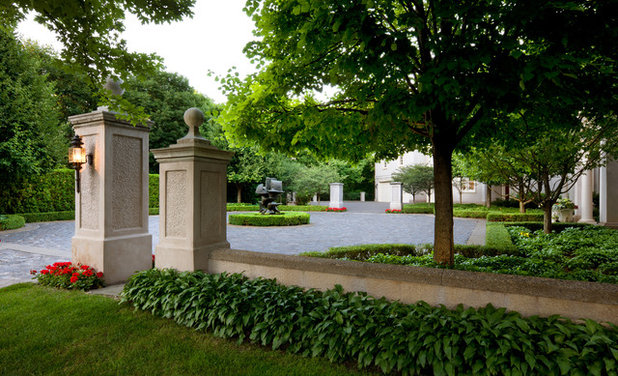
Windsor Companies
Carolina Basswood (
Tilia americana var. caroliniana)
Native from South Carolina south to Florida, west to Texas and north to Oklahoma and Missouri
Carolina basswood creates a very dense shade with a full canopy. As with other tilia (or linden) tree species, the early-summer flowers are aromatic and medicinal. This is a very handsome deciduous tree with a strong, upright, erect form that reaches 60 to 80 feet tall and 20 to 40 feet wide. It is reliable as a large, adaptable shade tree that tolerates most soils in its native range. Pictured is Carolina basswood’s northern-climate cousin, American basswood (
Tilia americana).
Water requirement: Medium; prefers moist but well-drained soil
Light requirement: Full sun
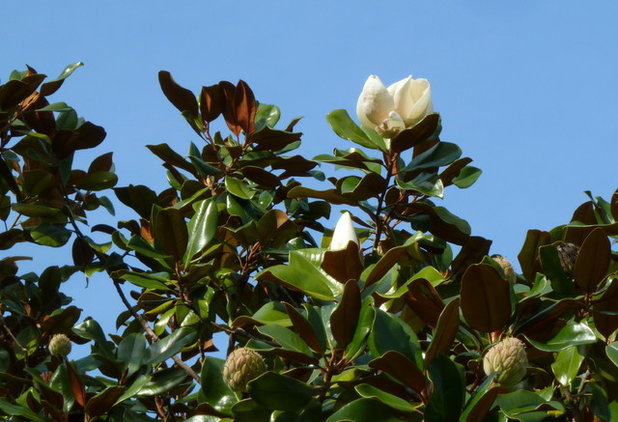 Southern Magnolia
Southern Magnolia(
Magnolia grandiflora)
Native to the southeastern United States; its native range extends throughout the Carolinas, Georgia, northern and central Florida, Alabama, Louisiana, Mississippi and into eastern coastal Texas
A large broadleaf evergreen tree with a pyramidal form when young, southern magnolia eventually reaches 60 to 80 feet tall and 30 to 50 feet wide. This tree produces large, fragrant flowers around Mother’s Day in the South. Their large, thick waxy green leaves with reddish-umber undersides make a lovely holiday wreath or addition to the Thanksgiving tablescape. Numerous cultivars exist for planting in smaller spaces as well.
Water requirement: Medium in its native humid climate, where there’s at least 40 inches of annual rainfall
Light requirement: In the seedling stage, southern magnolia can withstand some shade; as it matures, it requires full sun to flower and grow to its full mature height.
See how to grow southern magnolia
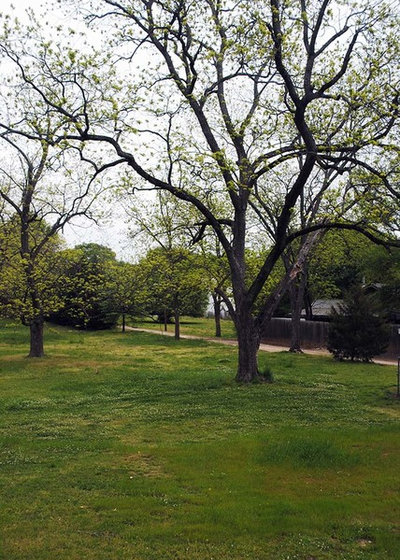
RTS Historic Homes
Pecan Tree (
Carya illinoinensis)
Native from Alabama to Texas, north to Ohio and parts of southeast Kansas
The pecan tree is important agriculturally for its delicious edible nuts. In the Southeast, the reliably warm and long growing season is perfect for producing a crop of edible nuts. Deciduous pecan’s large, spreading graceful form is similar to the American elm’s arching branches, but it is far less susceptible to disease. Plant pecan as a young specimen, because the taproot makes this species difficult to transplant. It grows 70 to 100 feet tall and 40 to 75 feet wide.
Water requirement: Medium; needs supplemental watering during dry spells
Light requirement: Full sun
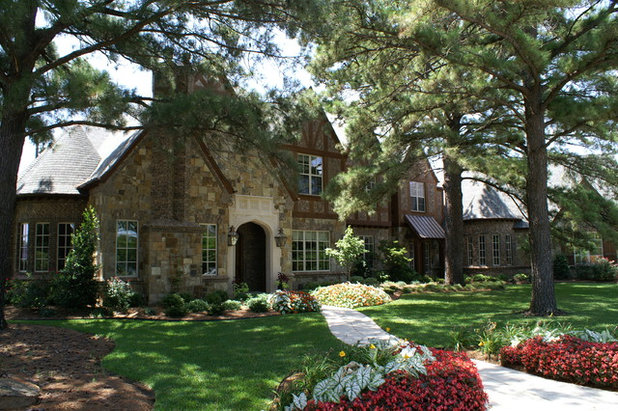
DeCavitte Properties
Loblolly Pine (
Pinus taeda)
Native throughout the eastern coastal plain from southern New Jersey to Central Florida
Loblolly pines are one of a handful of pines native to the Southeast. It is a reliable, fast-growing evergreen that’s drought- and wind-tolerant, reaching 60 to 90 feet tall and 30 to 40 feet wide. Plant it in clumps for the greatest effect, and mass trees together to create privacy and fast shade. Loblolly pine transplants and becomes established readily in sandy, well-draining soil.
Water requirement: Low to medium; somewhat drought-tolerant, but limited rain will reduce its growth
Light requirement: Full sun
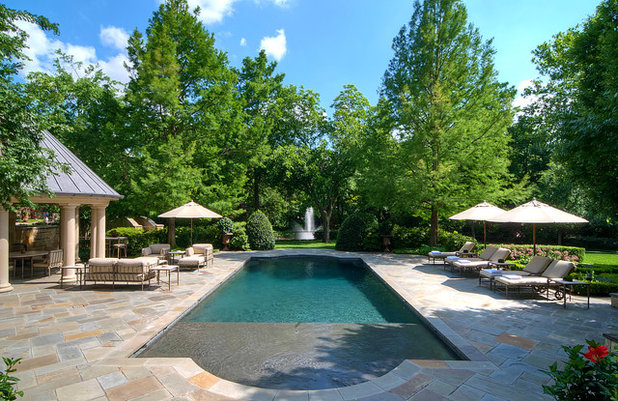
Harold Leidner Landscape Architects
Bald Cypress (
Taxodium distichum)
Native to eastern coastal North America and along waterways into eastern Texas and north to Southern Illinois
You can’t beat the feather-light texture of bald cypress foliage. The fine, short needles on this deciduous conifer turn out in early spring with a bright lime green color. Planted alone or clumped together, bald cypress casts a light dappled shade through the summer. To enjoy the space directly beneath them, you may need to prune some of the lower branches. Bald cypress fits well with black gum tree, as they can both withstand waterlogged soils. In swampy conditions, the trunk becomes buttressed and flared at the base. Bald cypress generally grows 50 to 70 feet tall — some old specimens tower above 100 feet — and 20 to 30 feet wide.
Water requirement: Water regularly until established; prefers moist soil but will tolerate dry conditions as well
Light requirement: Full sun but will tolerate shade
See how to grow bald cypress
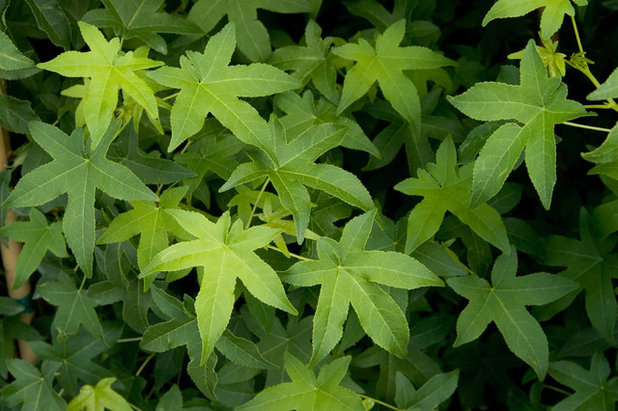
Monrovia
Sweetgum (
Liquidambar styraciflua)
Native from southern Connecticut south to Florida and into eastern Texas
One of sweetgum’s best qualities is its star-shaped leaves, which turn deep scarlet in autumn before dropping off. Plant this tree in an area where you won’t mind the spiny capsules that fall en masse and litter the ground. Sweetgum grows wild throughout the Southeast and reseeds easily in both wet and dry soils. It grows to 60 to 75 feet tall and 40 to 50 feet wide. The ‘Rotundiloba’ cultivar has round leaf tips and a purple-burgundy color.
Water requirement: Medium to high; sweetgum prefers moist soil
Light requirement: Full sun





